How a course creator & coach earned $2,820,782.48 (from 2020 to 2023)
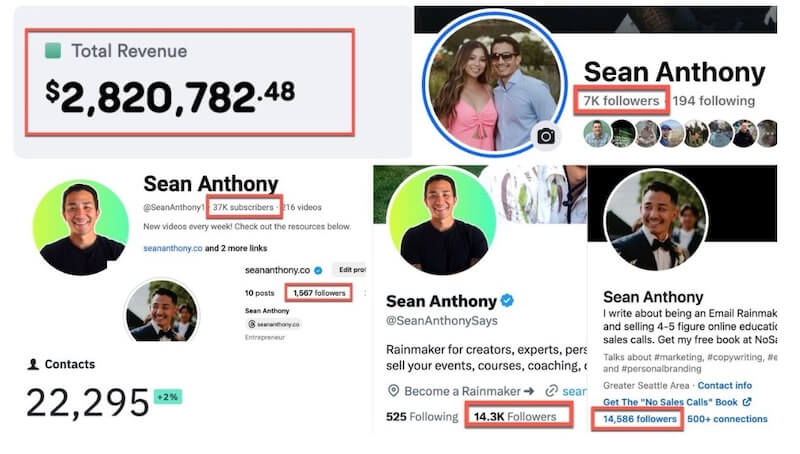
Today I’m going to show you how Sean Anthony did it (and how you can too).
How is this blog post different from others?

1/ Jump to specific sections
You can jump to specific parts of the post based on your current situation (using the table of contents above).
The most common pattern I see amongst folks is whether they have an existing audience to market to or not. You can quickly jump to the “don’t have audience” or “have audience” section.
2/ Each section has a “Strategy” & “Action” part
The “Strategy” explains the WHY behind the action, so you understand what’s going on (instead of just blindly following).
After you understand the principles, the “Action” shows you what to do (the implementation).
3/ Not covering niche selection or course topic
I’m not covering niche selection, course topic, pricing, or how to actually create the course.
Because the intent of this post is to show you step-by-step how to SELL online courses. That’s all.
If you’re looking for topics or ideas for your online course, go here.
Sean Anthony’s business model
He runs an information publishing / digital product business.
Specifically, Sean helps coaches, consultants, experts, course creators, agencies, and service providers get more clients + customers via his online courses and coaching programs.
Business model STRATEGY
Sean shows folks how he can solve their pains and problems. He doesn’t just show them the features of his online courses or programs.
For example:
- Selling features: This public speaking course has 5 modules, each 60-minutes long. There’s also a Zoom coaching call each month.
- Selling pains and problems: This public speaking course shows you the 5 simple steps any beginner can do to overcome their public speaking struggles and speak confidently on stage within 6 months.
Sean is also smart enough to understand different people have different needs and budgets.
To serve these different needs, he offers:
- Online courses for DIY learners
- Group masterminds for collaborative learning
- 1:1 coaching / mentoring for personalized guidance
Running these high-level programs has an added benefit: direct communication with customers.
This is gold as he can then leverage customer feedback to continuously improve his offerings.
The result? Happy customers who return to buy from him and refer him to their network.
Even though Sean has many different offers, he recommends selling high-ticket first before low-ticket.
Why?
2 reasons:
1/ Because most folks start with zero to little audience

If we want to earn a full-time income, selling a $27 or $97 ebook doesn’t make sense math-wise.
If our offer is high-ticket at $3,000 — we only need to get 1 client to hit $3,000.
But at $97 a pop? We’d need 31 sales to get to $3,000.
My question: how on earth are we going to get 31 sales when we have little to no audience?
However…
If we have 100,000 email subscribers:
- At a 1% sales conversion rate, 3,100 folks need to see the sales page
- At a 3% email clickthrough rate to our sales page, we need 103,000 email subscribers
If we only have 1,000 subscribers, trying to crack 4-figure/month by selling $97 ebooks is like trying to win an Olympic gold medal with only a month of training lol.
But if we have 100,000 subscribers, 4-figure/month is not only easier to achieve… we can hit that goal way faster.
2/ It gets you clarity on what your “main offer” should be
The “main offer” is the main thing you want to sell. Usually, this is your biggest revenue generator a.k.a. highest priced offer.
Knowing what your main offer is gives you clarity on what your other offers should be in your funnel:
- Low ticket offer
- Free offer
By focusing on the main offer, you create + position the low-ticket and free offer AROUND the main offer, not the other way around.
Because if you do it the other way around, you’re doing it backward and the “flow” will not be as natural or congruent.
✅ Main offer → Low ticket offer → Free offer
Yet most people do it backward:
❌ Free offer → Low ticket offer → Main offer
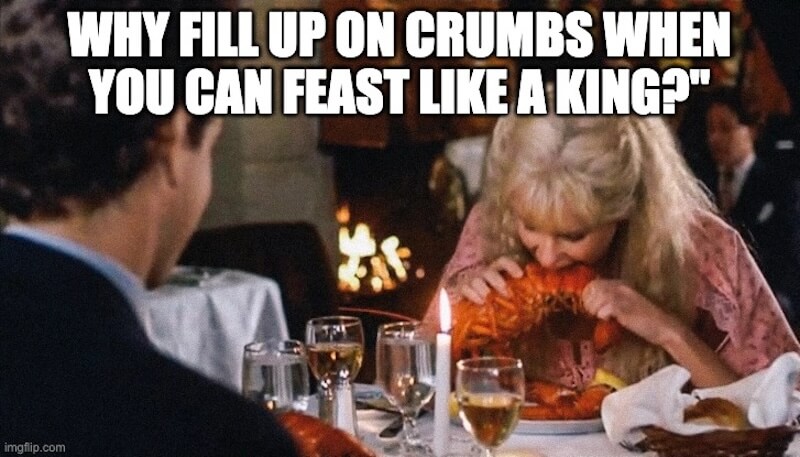
Sean calls these 3 (main offer, low-ticket offer, free offer) “The Offer Buffet”.
He believes every course creator, coach, and consultant should have an Offer Buffet to serve different people based on (1) their budget and (2) how badly they need help.
Sean also offers a payment plan for his high-ticket offer.
Note: I try to keep this post as noob friendly as I can, but sometimes I need to use certain digital marketing terms. If you’re unsure of any terms, feel free to click the previous link for an explanation.
Business model ACTION
Create your Offer Buffet in the following order:
1/ Main Course (high-ticket offer priced between $1,000 – $100,000+)
This can be a cohort or online course with a group mastermind / coaching component or even a DFY (done for you) service.
Preferably, this is a continuity offer where clients pay you monthly or yearly. This way, the revenue is predictable and you don’t have to keep finding new clients every month.
2/ Sample (free lead magnet)
This is something USEFUL you give away to your target audience.
To get it for free, they’d have to give you their email address — i.e. you build your email list.
But it’s not just about “building another freebie email list”…
It’s about building a list that wants the outcome of your main course. This is why the Main Course comes before the Sample.
The Sample is for folks to consume your free stuff first — to whet their appetite and warm them up so they want to work with you by getting your Main Course.
3/ Appetizer (low-mid ticket offer priced between $1 – $1,000)
Sean finds the sweet spot is between $1 – $300.
Appetizers are 1-2 hour of live zoom trainings with Q&A at the end.
Apart from getting “some nice change”, it’s also a way for people who haven’t done business with you to try a “paid sample” of your methodologies / philosophies and see how you “vibe”.
If they like what they see, they’ll want to come back for more (i.e. buy your Main Course).
.
You can find out more about Sean Anthony here.
If you do NOT have an audience yet

No audience STRATEGY
1/ Get your first 3-5 clients by doing things manually & unscalably
Most folks want to “scale” or “skyrocket” or “10x” their sales. Well, we can only do so when we’ve got momentum.
Last I checked, 10x of zero is still zero, no?
In the beginning, forget about trying to scale. Do things manually. Aim for no leverage in your sales funnel activities.
Don’t be sucked into the “skyrocket” hype lol.
Can’t run if we don’t even know how to walk properly.

2/ Sell before building
We don’t want to be wasting time building an offer / product only for it to flop.
To counter this, talk to people and see what they need help with.
Then show how you can help them.
Then collect the money ($).
Only after that you build the offer.
For DFY services, you ask for a deposit or full upfront payment, then you work on the task.
For non-DFY services like courses or coaching, you provide the training / coaching LIVE… AFTER you’ve sold and collected the money.
No audience ACTION
Since you don’t have any audience at all, Sean suggests doing cold outreach to your target audience.
Keyword: “target audience”, not just anyone and everyone.
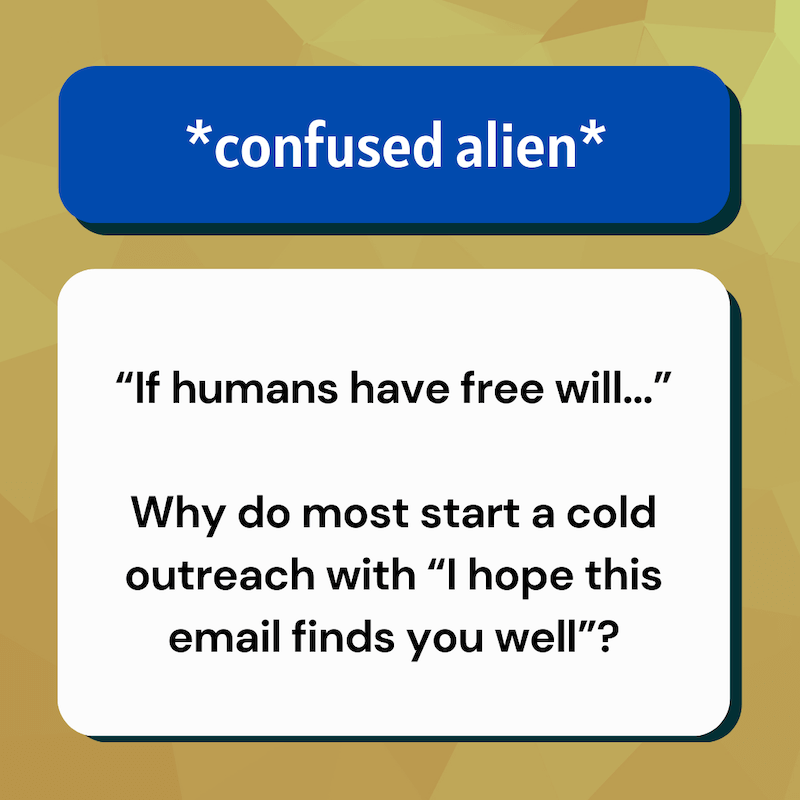
The cold outreach can be through Facebook / LinkedIn / any social media platform’s DM (direct message) system.
Most folks do cold outreach with a “me me me” mindset…
Where it’s only about the sender trying to take something from the recipient.
If you do the opposite — you’ll instantly stand out.
Start the conversation by giving away something USEFUL for the recipient (your “Sample”).
I repeat because this is key — USEFUL. For. The. Recipient.
It can’t just be another regurgitated blog post or video written by some writer using AI without “field experience”.
This Sample outlines your method / protocol on how to achieve the outcome of your Main Course.
Example:
Here’s a protocol on how to extract a 6-figure yearly cash flow from an email list using the DAN method:

After you’ve created this protocol (Sample), you send outreach messages that look like this:
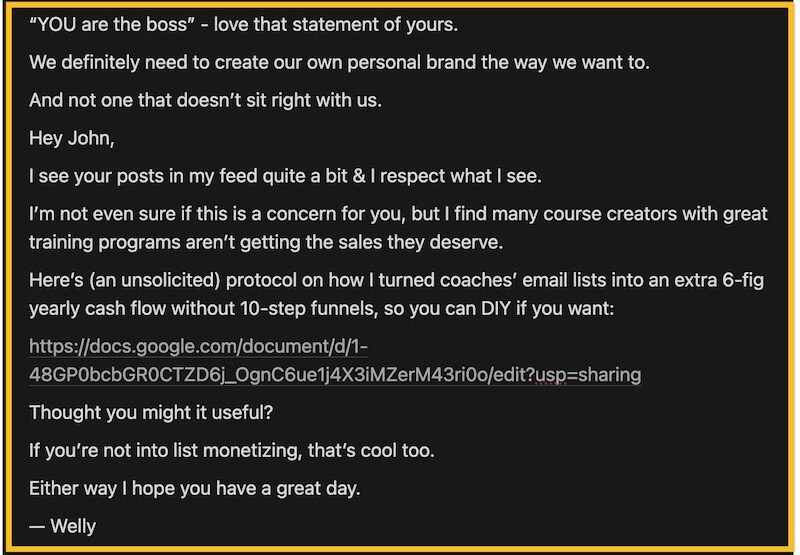
Note:
1/ I start the “marketing” message by leading with something familiar and unique to the recipient
In this case, the recipient likes to say “YOU are the boss”.
I do this to instantly build rapport so they want to read further.
2/ I use Google Doc for the link to the Sample because it’s a safe & familiar link everyone knows
If I use a private / external website link, they might worry about malware and viruses.
This is also why the link should be inserted “nakedly” (where folks can see where the link takes them to when clicked)…
Instead of masked with a custom text (e.g. click here — I don’t know where this link is taking me to)
3/ The Google Doc lays out the step-by-step protocol on how to achieve the promised result
At the end of the doc, the reader is invited to either “DIY” (do it yourself) by following steps outlined or hire you to do it for them.
Here’s the cold outreach template you can use:
[Say something that’s unique to them that they’ll instantly recognize, so that they know you’ve done your homework before reaching out].
Hey [Name],
I see [how you discovered them] & I respect what I see.
I’m not even sure if this is a concern for you, but I find many [target audience] with great training programs aren’t getting [desired result].
Here’s (an unsolicited) protocol on [”Sample” that shows how to get desired result] without [thing they hate], so you can DIY:
[Link to resource – preferably in Google Doc / YouTube (if video)]
Thought you might find it useful?
If you’re not into [thing you help them with], that’s cool too.
Either way I hope you have a great day.
— [Your name]
You can also do semi-warm outreach by finding the recipient on social media first. Then comment on their posts a few times. Only after that you send the outreach message. Doing it this way should get your message a higher chance of being read and responded.
If you already HAVE an audience
Have audience STRATEGY
1/ We don’t know where people are in the buying journey
Some folks buy faster because they’re in immense pain and are desperate to make it go away now.
Some people buy later because it’s not a good time for them right now. That’s why we want to be in their “top-of-mind” — so that when they do want / need the offer we provide, we’re their first choice.
Most will never buy — which is totally okay. That’s how business is supposed to be. Only a small segment of people will buy our shyt.
The best way to stay top-of-mind is via emails. Email is how we get strangers to (K)now, (L)ike, and (T)rust us (KLT).
The bigger the KLT, the easier it is to sell our offer.

To build KLT, we need to “capture” their email address. Otherwise we have no way of keeping in touch with them.
Plus, when we have their email address, we “own” our database of leads — that no one can take it from us…
Regardless if our social or Facebook ad accounts get closed…
Or Google changes its algorithm via some panda or monkey updates.
2/ Emails can be automated (or at least semi-automated)
The best thing with emails is some of the emails we’ll send are automated.
In the world of marketing automation, this is called a Welcome Email Sequence.
We write 3-5 emails once. Then load these emails into our Welcome Email Sequence. To do this, we need an email marketing tool like BirdSend or any legit one will do.
Apart from building KLT, this sequence:
- Builds your credibility
- Positions you as the authority
- Talks about common pain points, rubs salt on the wound, and gently suggests we have the solution
- Invites them to work with us (keyword: “invite”, not aggressive selling)
I want to reiterate in case you didn’t catch how powerful this is — the Welcome Email Sequence will send 3-5 emails on our behalf AUTOMATICALLY regardless if we’re snoring like a bear, taking a vacation with our family, or out there deep in the jungles of Amazon with no internet connection.
3/ Don’t rely on a sales page to sell high-ticket
Selling high-ticket offers via a static sales page is tough, even if our copy is written by the best copywriter on earth.
Most folks aren’t going to part with thousands to tens of thousands of dollars without having their questions / concerns answered.
A better way to get more sales conversions is by CCC:
Content (C) → Conversation (C) → Conversion (C)
The Content can be social or email content.
The Conversation can be via emails, chats, calls, or a combination.
Have audience ACTION
1/ Prepare this DM / email:

Note:
Make it SUPER EASY for them to reply with a “yes” or “no”. Don’t ask open-ended questions. You can ask more clarifying questions AFTER they reply “yes”.

Here’s the template you can use:
Hey [Name],
I’m putting together a [Main Course] for [target audience] to [desired result].
You’re a [target audience], so I thought it might be a fit.
Would you be open to hearing more?
— [Your name]
2/ Then send the above message in this order of most to least likely to buy:
- Previous clients whom you’ve gotten good results for
- Existing clients and customers
- Direct network that are a good fit for your offer
- Leads / prospective students you’ve conversed before via chat / email / call
- Email list
- Social followers
3/ Next, continue to consistently build your email list
To do this, post USEFUL + RELEVANT content on social media.
At the end of the content, give away your lead magnet (Sample).
To get it, they’d need to get give you their email address.
E.g.

Also optimize your social profile so that it links to your Lead Capture Page, like this:

A Lead Capture Page (LCP) is a landing page where visitors can only do 1 of 2 things:
(A) Opt-in by entering their email address to get the free lead magnet or
(B) Exit the page
Because there’s no other distractions (only 2 choices), you’ll get more people opting-in.
That’s how you do social media marketing.
High-converting Lead Capture Page tips:
Headline
The headline is the most important since it’s the first thing visitors see when they land on the page. If you don’t capture their attention in 2 seconds, they’re gone.
Follow this headline structure to catch their attention:
- Call out to the specific who / audience
- Desired result (”avoid hell” or “move closer to heaven”)
- Timeframe
- Social pqroof (show you’ve achieved the desired result or helped someone achieve it, can also use screenshot or video testimonial)
For my $26k in 6 days case study, here’s how each of the above elements come into play:

Body
If you do a good job with the headline, you don’t need to talk too much for the body copy.
Just make it straightforward like: “Tell me where to send the [Sample]” (see screenshot above).

4/ How to sell in every email (without looking like selling)
You use S(E)CTS.

(S)tory
(E)xample
(C)rux
(T)ransition
(S)ell
(S)tory
We open the email with a story because (1) most people don’t — hence we stand out and (2) humans love a good story.
The story doesn’t have to be anything stellar.
Use the WWW simple story framework:
(W)hen, (W)here, (W)hat happened.
E.g. Last Friday, as I was in enjoying my morning Starbucks coffee, someone in a Spiderman costume suddenly banged on the door…
(E)xample
Then we provide an example or fact related to the story (if applicable).
Sometimes the example is already provided in the story part, which is why the example is optional (hence in parenthesis).
(C)rux
Next, we provide a crux / takeaway / lesson that can be learned from the email.
(T)ransition
Then we create a “bridge” to transition to the next part (selling). The smoother the transition, the less obvious the sell.
(S)ell
Finally, we sell our shyt and insert the CTA (call to action).
“Sell” here doesn’t necessarily mean selling a paid offer.
Asking folks to click a link to our latest blog post or YouTube video content is also considered selling since we’re asking them to do something.
Formula recap
From the subscribers’ point-of-view:
We’re just telling a story, showing an example or fact, sharing the main lesson behind it, & inviting them to solve their problems by trying our solution.
E.g.

5/ Create your Welcome Email Sequence
After people opt-in with their email address, put them into your Welcome Email Sequence that has 3-5 emails in it.
Here’s what you can talk about in email on a daily basis:
Email #1 — Deliver lead magnet
Deliver what you promised on the Lead Capture Page (the “Sample” / lead magnet).
Put the lead magnet content directly in the email message if possible. This trains people to open and read your emails.
At the end of the content, soft-sell your shyt offer at the end.
E.g. My lead magnet is a case study on how I helped a coach pocket $26k in 6 days via emails
- I wrote the case study directly in the email message
- Then I did a quick self intro
- At the end, I soft sell them to my high-end program

Email #2 — Are you X or Y?
This is a super short and simple email.
Basically you’re just asking them the 2 things they want as they relate to your business.
For example, my target audience are coaches and course creators. The 2 things they want as it relates to my email marketing business are (1)build an email list and (2) monetize an email list.
So I wrote this:

Email #3 — Contrarian
There’s no shortage of information, anyone can just Google or ChatGPT their way to any information anytime they want.
So if you want to stand out, become memorable, and stay top-of-mind…
→ Have your own opinions
→ Have your own character
→ Have your own philosophy
→ Have your way of doing things
Also talk about what you hate and love (as they relate to your industry).
Example:
For me, I can’t stand when people use the lame “subscribe to my newsletter” as the CTA / main selling point to persuade people to join an email list.

Like for real…
Are we Tom Cruise? Are we Taylor Swift? Are we Elon Musk?
Ok… we don’t have to be as famous as them… but are we at least someone well-known in our small niche?
No? Then nobody wants to “suBsKriBe to another neWslEtta”.

Email #4 — Proof
Show results you’ve achieved for yourselves (as it relates to your niche) and / or for clients.
Showcase case studies, before / after results, testimonials, etc.

Email #5 — Direct pitch
This is straightforward. For this email, you bluntly tell them how you can help them.
Again, in a non-salesy way. No aggressive or pushy selling.
A short, simple explanation on how you can help… and then asking them to reply is enough, like this:

Bonus: Abandoned cart emails
This are 1-2 emails you send to people who almost bought.
They’ve partially filled out their information on your checkout page, but for some reason didn’t complete the checkout.
This is as low-hanging fruit as you can get. It means they’re very interested in your offer.
A great way to recover these lost sales is to send 1-2 abandoned cart emails using these abandoned cart email templates.
Continue sending weekly emails after they complete the Email Welcome Sequence
After subscribers complete the Welcome Sequence, continue to email at least weekly on a continuous basis.
The more emails you send, the more potential sales you get though. I currently send 3x emails a week. Sean sends daily emails.
Why? Because in (almost) every email, we’re going to sell our shyt. And because we use the S(E)CTS formula, the emails aren’t sleazy or salesy.
But what to write about in these emails?
Use the 7×7 topic matrix:
(A) 7 sub-topics
E.g. Say I’m a public speaking coach for professional men. I need to come up with 7 sub-topics for public speaking. We can use AI to help us:

Here’s what it gave me:

Here’s the prompt you can use:
I’m a [profession] for [target audience]. What are 7 sub-topics within “[profession]” I can cover in my content?
(B) Next, combine the 7 sub-topics with these 7 “angles”:
- Myths
- How I / How to
- Mistakes
- Wins / Proof
- Contrarian
- Inspirational
- Entertaining
You’d then have the 7×7 matrix:
- Overcoming speech anxiety x Myths
- Overcoming speech anxiety x How I / How to
- Overcoming speech anxiety x Mistakes
- Overcoming speech anxiety x Wins / Proof
- Overcoming speech anxiety x Contrarian
- Overcoming speech anxiety x Inspirational
- Overcoming speech anxiety x Entertaining
- Crafting compelling content x Myths
- Crafting compelling content x How I / How to
- Crafting compelling content x Mistakes
- Crafting compelling content x Wins / Proof
- Crafting compelling content x Contrarian
- Crafting compelling content x Inspirational
- Crafting compelling content x Entertaining
Etc.
You can also ask AI to help you:
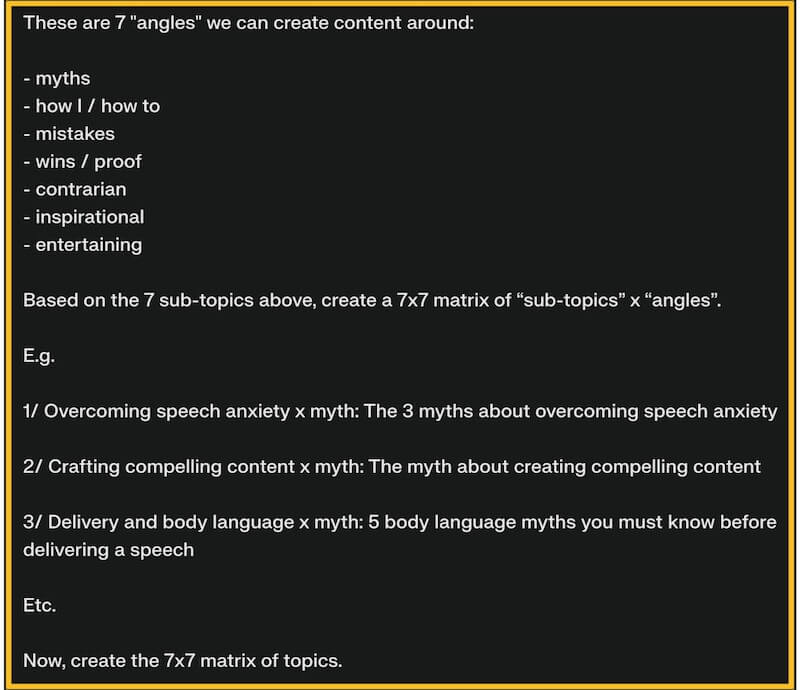
It’ll give you 7 x 7 = 49 content ideas:

Here’s the prompt you can use:
These are 7 “angles” we can create content around:
- myths
- how I / how to
- mistakes
- wins / proof
- contrarian
- inspirational
- entertaining
Based on the 7 sub-topics above, create a 7×7 matrix of “sub-topics” x “angles”.
E.g.
1/ [Sub-topic 1] x myth: The 3 myths about [sub-topic 1]
2/ [Sub-topic 2] x myth: The myth about [sub-topic 2]
3/ [Sub-topic 3] x myth: 5 [sub-topic 3] myths you must know
Etc.
Now, create the 7×7 matrix of topics.
Income boosters
Income boosters STRATEGY
When you’ve built up 10 client case studies, you can create smaller, low-ticket DIY offers (Appetizers) to sell to those who haven’t bought your high-ticket (Main Offer).
And because these are DIY offers:
Regardless if you sell 10 or 100 or 1,000 units… it doesn’t cost you extra personal time and involvement to “deliver” the offer / product.
Because customers can simply access your materials online or download them on their own.
There’s also no production costs.
So your profit margin is very close to 100%

In your DIY offer, upsell them to your Main Course (high-ticket).
The core material / strategy is the same for your Appetizer and Main Course — the difference is “how much access to you”.
Appetizer = no access to you.
Main course = access to you to ask questions (consulting), get your feedback, get coaching, etc.
Income boosters ACTION
1/ Create a low-mid ticket Appetizer (DIY) offer ($50 – $500).
This can be a 1-2 hour of live zoom training with Q&A at the end. Make the training actionable and zero-fluff… so that after the training, they can implement what they just learned and get a quick win.
This is also a way for folks who haven’t done business with you to try a “sample” of your paid teachings / methodologies first. If they like what they see — especially if they get a quick win — they’ll be more likely to buy your Main Course.
2/ On the Appetizer download / access page & inside your emails, upsell them to your Main Course:

Here’s the template you can use:
Thanks for buying [product X]. It’s great to have you!
I’m sure if you [do this thing], [you’ll get good results].
If you’re like most [product X] customers, you probably have this question, “Now that [thing that product X enables people to do]… how do I [next challenge]?”
Here’s how:
[High-level solution].
I cover how to do that exactly in [product Y].
Since you’ve just bought [product X]… I’ll give you a special [Y%] off for the next [Z] hours only.
Click here to claim it & [desired result].
If not, that’s cool too.
Note:
We add a “If not, that’s cool too” so we don’t sound salesy. We give the control back to them.
Recruit affiliates for more sales
Recruit affiliates STRATEGY

This is basically “free money” for you because you only pay affiliate commission after a sale is made.
Some internet marketers call this a “joint venture” — which I don’t really agree with.
In a true joint venture, the other party is much more involved than just in the “promotion” part. They usually contribute to the “product creation” aspect too.
Granted, your online course must be USEFUL so that affiliates are confident in promoting it to their audience.
I suggest recruiting affiliates when you’ve sold at least 100 copies and / or you’ve established a solid reputation in your industry.
Why? Because nobody wants to promote a nobody’s offer (pun intended).
- For hands-off low-ticket (Appetizer) online courses that don’t require any of your extra time and energy, 50% is a common commission percentage.
- For high-ticket (Main Course) masterminds or courses with a coaching aspect, expect to pay 20% – 30% in commissions.
Note: If you’re into statistics, here’s a list of key affiliate marketing stats.
Recruit affiliates ACTION
When you’ve sold at least 100 copies of your low-ticket online course…
Sign up for a platform / tool that supports affiliate tracking capabilities.
So that you can track who bought, when, how much, who referred, etc.
Some tools that can do this: CartMango, Gumroad, Clickbank, Teachable, Thinkific.
Sell online courses FAQs
How profitable is selling online courses?
- You saw how Sean Anthony earned $2.8+ million USD in 3 years.
- The online learning market size is projected to reach $319 billion by 2029 (Source: Fortune Business Insights). If you just get a super small piece of this pie, you’re still in good hands.
- As of 2024, coursera — an online learning platform — had a total of 155 million users (Source: Business Wire).
What kind of online courses sell the most?
Here are the top 5 in order of most to least popular:
- Business and entrepreneurship
- Technology and programming
- Health and wellness
- Marketing and sales
- Personal development
Is it legal to resell online courses?
Not unless you have the explicit consent of the course creator to do so. Click here for more info on this topic.
Why is my course not selling?
Asking this question is like asking “why am I not successful”.
It’s too broad to provide an answer without diagnosing the issue.
Why not review the strategies outlined above? Ask yourself if you have an audience or not — and start from there. If you already have an audience, go here. If no audience, go here.
What is the best platform for selling courses?
It depends on your specific need and format.
Do you need a LMS (Learning Management System) to deliver your course? Or is your content format just a few simple pdfs and videos?
Do you want an all-in-one platform that can take payments and also has built-in marketing features? Or just the “taking payments” part?
Do you want the promotion of your course done for you? If yes, you may want to list it in an online course marketplace like Clickbank or Udemy.
Caution though: Udemy doesn’t give you access to your students’ email address — which, in online business — is the most important asset you can have.
Some platforms / tools are more suited for certain types of businesses, so make sure to do your due diligence.
How do I sell an online course with no followers
Build an audience. Then sell to them. I already explained in detail in this section.
Recap
If you don’t have an audience yet, start with cold outreach to get direct sales. At the same time, start building your email list too by posting on social media.
If you already have an audience, make sure you’re also building an email list. Because email is the most profitable marketing channel + you OWN your list of customers and leads (that nobody can take from you). When it comes to selling, you sell in (almost) every email using the S(E)CTS formula so you don’t come across as sleazy.
Sources
Click to view
- Imgflip for the memes
- Fortune Business Insights
- Business Wire
- Udemy
